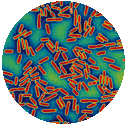
Image: CELLS alive!
- Also a part of this story: Cross Purposes — the Red Cross promotes questionable products to hospitals.
Prospective patients often choose a hospital after considering the reputation of its medical staff, the sophistication of its technology, perhaps even the comfort of its wards. But one invariably overlooked category — the hospital’s disinfectant — could determine whether their stays turn deadly.
More and more, hospitals are becoming sources of infection. Dr. William Jarvis, chief of investigation and prevention for the Centers for Disease Control and Prevention’s Hospital Infections Program, estimates that at least 80,000 patients die each year from infections they acquire after entering the hospital. That makes hospital infections the nation’s fourth most common cause of death, accounting for more mortalities than car accidents and homicides combined. Jarvis believes that about 5 to 10 percent of patients — from 1.75 million to 3.5 million people annually — contract infections while hospitalized, a rate experts estimate has probably increased at least 50 percent in the last decade.
 But despite the rise in infections, the Environmental Protection Agency has failed to monitor the disinfectant industry effectively. In 1990, the government’s General Accounting Office (GAO) reported that the EPA had acknowledged that “as many as 20 percent of marketed disinfectants may be ineffective” — and the EPA has done little to put a dent in that figure. Although the EPA is supposed to examine all disinfectants and keep unregistered products off the market, many manufacturers don’t register their products, gambling that the EPA will not use its authority to halt product distribution. This places responsible manufacturers at a substantial disadvantage, since they pay lab and consulting fees that usually range from $50,000 to $100,000 and wait six to 18 months to gain registration for their products, while their competitors flout the law.
But despite the rise in infections, the Environmental Protection Agency has failed to monitor the disinfectant industry effectively. In 1990, the government’s General Accounting Office (GAO) reported that the EPA had acknowledged that “as many as 20 percent of marketed disinfectants may be ineffective” — and the EPA has done little to put a dent in that figure. Although the EPA is supposed to examine all disinfectants and keep unregistered products off the market, many manufacturers don’t register their products, gambling that the EPA will not use its authority to halt product distribution. This places responsible manufacturers at a substantial disadvantage, since they pay lab and consulting fees that usually range from $50,000 to $100,000 and wait six to 18 months to gain registration for their products, while their competitors flout the law.
Meanwhile, according to Jarvis, the role of disinfectants in preventing the spread of hospital infections has become “increasingly important.” Most disease-causing pathogens cannot survive outside the human body — on the bed railings and doorknobs, for example, that are typically cleaned with disinfectants. In the last few years, however, lethal antibiotic-resistant organisms that can survive outside the body have become endemic in many U.S. hospitals. As a result, ineffective disinfectants are “absolutely” a cause for concern, Jarvis says. And hospitals aren’t the only place where disinfectants prevent the spread of infection: They are routinely used in medical and dental offices, school nurse stations, daycare centers, and veterinary clinics.
 The EPA has repeatedly acknowledged the importance of disinfectants. In March 1996, Steven A. Herman, the EPA’s assistant administrator in the Office of Enforcement and Compliance Assurance, said that a primary focus of his Toxics and Pesticides Enforcement Division would be “continued efforts to remove from the marketplace ineffective and/or unregistered disinfectants used in hospitals and other critical care facilities.” Nevertheless, Jesse Baskerville, the director of that division, has conceded that between October 1, 1995, and mid-December 1996, his office did not enforce a single case against a disinfectant manufacturer. (While the EPA says its regional offices also investigate manufacturers, officials cited only one case in which distribution of an unregistered product was halted during this period.)
The EPA has repeatedly acknowledged the importance of disinfectants. In March 1996, Steven A. Herman, the EPA’s assistant administrator in the Office of Enforcement and Compliance Assurance, said that a primary focus of his Toxics and Pesticides Enforcement Division would be “continued efforts to remove from the marketplace ineffective and/or unregistered disinfectants used in hospitals and other critical care facilities.” Nevertheless, Jesse Baskerville, the director of that division, has conceded that between October 1, 1995, and mid-December 1996, his office did not enforce a single case against a disinfectant manufacturer. (While the EPA says its regional offices also investigate manufacturers, officials cited only one case in which distribution of an unregistered product was halted during this period.)
One reason for the EPA’s ineffectiveness is lack of money. A 1982 budget cut forced the agency to give up its lab, where products were tested before they could be registered. Since then, the EPA has merely required manufacturers to provide data produced in-house or by hired labs — an arrangement that evokes frequent references to foxes in henhouses. In addition, continuing budget cuts have impaired the EPA’s ability to inspect private labs and enforce disinfectant regulations.
The EPA is also plagued by bureaucratic inertia and indifferent leadership. Last October, for example, a lawyer for a disinfectant manufacturer, frustrated by the agency’s reluctance to move against unregistered products, implored officials at the EPA’s Chicago regional office to attend a nearby trade show where, he assured them, they would see many unregistered disinfectants on display. Two officials visited the show and found “20-some” products that were “problematic,” according to John Ward, chief of the region’s pesticides program section. Nevertheless, six months later, the EPA had taken no action against any of the products.
A more disturbing demonstration of the EPA’s inertia involves Kyle Sibinovic, a lab owner and regulatory consultant in Bethesda, Maryland. Since 1973, Sibinovic has submitted more than 100 lab studies to the EPA, backing the registration of at least 19 different disinfectants and sterilants. Sibinovic has been investigated by the EPA’s Criminal Investigation Division and the U.S. Attorney’s office in Greenbelt, Maryland, to determine whether she might have falsified any of those studies. The agencies would neither confirm nor deny that an investigation is ongoing.
Beginning in 1994, Kenneth Palmero, the owner of a small disinfectant company in Stratford, Connecticut, contacted the EPA with his suspicions about Sibinovic. Palmero hired Sibinovic in 1989 to help him gain EPA registration for his disinfectant, DisCide. Over the next two years Palmero grew increasingly uneasy as Sibinovic’s EPA submissions, based on her lab tests of DisCide, provoked letters from the EPA questioning her study designs and lab procedures, and asking for more data.
Frustrated by his inability to get EPA approval despite, he says, having paid Sibinovic $120,000 in lab and consulting fees, Palmero hired new consultants, who advised him to use another lab to redo the tests. The new lab’s findings flatly contradicted Sibinovic’s: While she claimed DisCide killed the polio virus — a pleasant surprise to Palmero since the EPA doesn’t require disinfectants to kill polio — the new lab reported that the product did not destroy the virus.
The new lab also repeated the tests Sibinovic had performed on DisCide, but used more rigorous procedures. This time, within 10 months of submitting a new application, Palmero received EPA approval for his product.
Palmero then discovered that Sibinovic had done lab work and consulting to aid the EPA approval of Sani-Cloth, one of DisCide’s competitors in the “hard-surface wipe” segment of the disinfectant market. Unlike DisCide, Sani-Cloth claimed to kill the polio virus. But the only significant difference between Sani-Cloth’s and DisCide’s active ingredients is that DisCide contains 63.25 percent isopropyl alcohol, while Sani-Cloth contains only 8 percent, a level generally considered insufficient for effective disinfectant use. When Palmero submitted both DisCide and Sani-Cloth to another lab for comparative efficacy testing, the lab reported that Sani-Cloth also did not kill the polio virus. Equally important, it reported that while DisCide killed the three bacterial pathogens necessary for EPA registration, Sani-Cloth did not.
Sani-Cloth is produced by an Orangeburg, New York, company, Professional Disposables Inc. After he was contacted by Mother Jones in mid-April, Robert Julius, president of PDI’s parent company, Nice-Pak Products, said in a written statement that all Nice-Pak products “are in full compliance with EPA registration standards.” Nice-Pak also reports that it removed its polio claim from its label in July 1996.
Palmero and his new consultants presented information about Sibinovic to EPA enforcement and Justice Department officials in three meetings between November 1994 and April 1995. By that time, Palmero had found that Sibinovic had conducted lab tests for at least five other products that had drawn EPA disciplinary actions in the early 1990s for having failed to perform according to their claims. Since then, EPA officials have shown great interest in Palmero’s account of his interactions with Sibinovic, but they have not taken any action against her.
Informed of Palmero’s charges by Mother Jones, Sibinovic denied the allegations, and added, “I think a public forum is probably the most negligent way that anybody could make such an accusation. I think that if you have a problem [with someone], you go to them and you [try to] reconcile it before you do anything else.”
Even before Palmero approached the agency about Sibinovic, the EPA had reason to doubt the accuracy of her research. In response to the highly critical 1990 GAO report, EPA officials decided to conduct efficacy tests on all registered medical germicides, starting with sterilants, the highest classification. Sterilants are used in cleaning medical instruments, such as catheters and endoscopes, that are inserted inside people’s bodies.
The results of the EPA’s review showed the limitations of relying on data submitted by manufacturers: Of the 27 sterilants tested, 18 failed. And Sibinovic had supplied the data for nine of those 18. The EPA’s review of sterilants also underscored the agency’s glacial work pace. It took the EPA four and a half years after the publication of the GAO report to complete its analysis of the 27 sterilants. Yet, for all their importance, sterilants constitute only about 1 percent of germicides.
In 1995, after finishing its examination of the sterilants, the EPA began testing 800 registered products in the much larger field of disinfectants. Doreen Aviado, testing program coordinator for the EPA’s Antimicrobial Division, estimates that the review will take three to five years to complete. Even that estimate may be greatly optimistic. In the two years since the review began, the agency has analyzed only about 20 disinfectants.
















